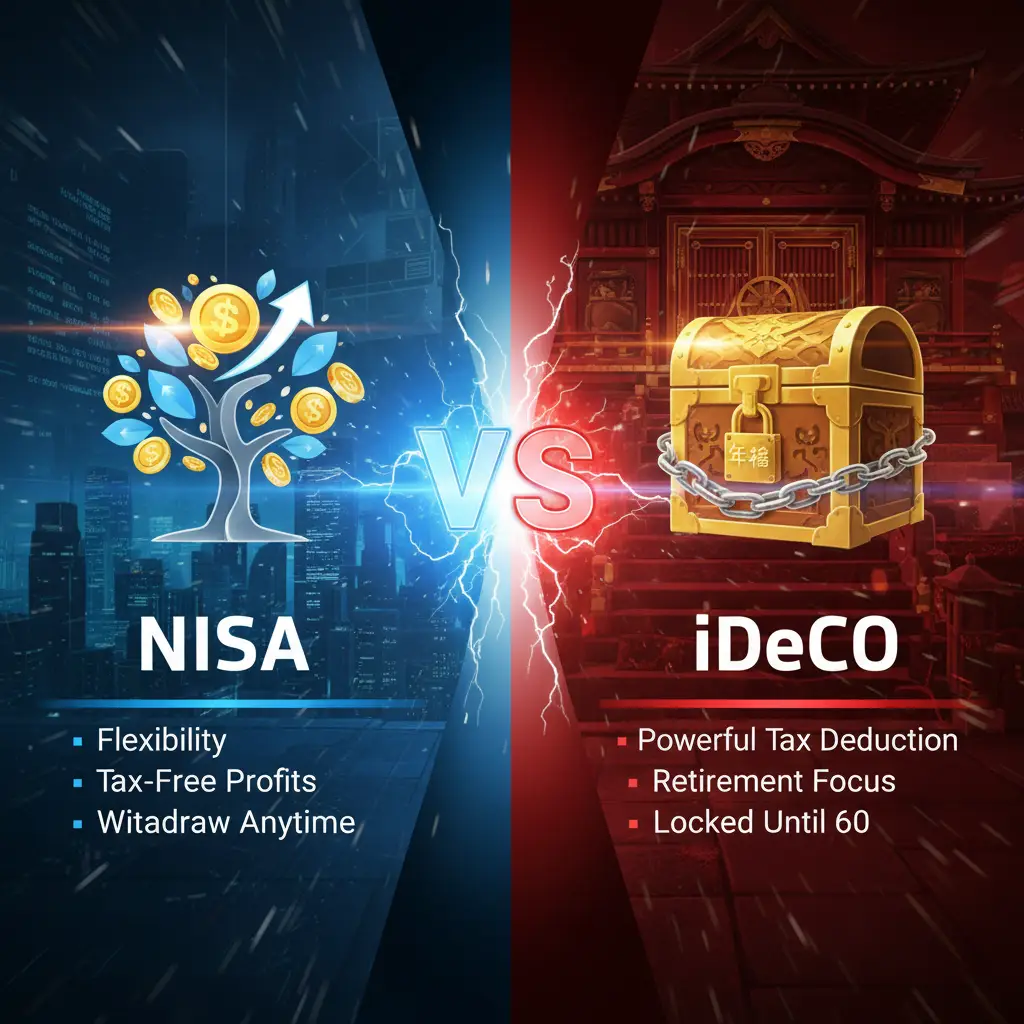Finding Your Financial Balance After 40 in Japan
For many foreigners living in Japan, life after 40 is an exciting adventure.
Meanwhile, it’s also the time when thoughts naturally turn toward financial security.
When exploring your options, one question always comes up — iDeCo vs NISA in Japan.
Still, if these terms sound confusing, you’re not alone. And the best part? It’s never too late to begin.
💡 This post may contain affiliate links. If you click and book through my link, I may earn a small commission at no extra cost to you. Thank you for supporting this blog!

This topic comes up in nearly every conversation I have with my foreign friends. They build a great life here, then realize: “Wait… how do I prepare for retirement in Japan?”
Fortunately, learning the difference between iDeCo vs NISA in Japan is one of the most empowering financial steps you can take.
Let’s break it down simply — no jargon, just a friendly chat.
What Is iDeCo vs NISA in Japan?
Think of both iDeCo and NISA as supercharged savings accounts.
While a regular savings account just sits there, these help your money grow — and offer amazing tax benefits.
- NISA: Your flexible, tax-free investment account. You can access your funds anytime.
- iDeCo: Your disciplined retirement account. It rewards you with powerful tax deductions — but you can’t withdraw until age 60.
Together, they form the backbone of smart financial planning in Japan.
NISA in Japan: The Best Way to Start Investing
If you’re just starting out with iDeCo vs NISA in Japan, NISA is the easiest door to open.
It’s beginner-friendly, flexible, and available to almost everyone living in Japan.
✅ Easy to Qualify
If you’re over 18 and have a My Number card, you’re in — regardless of your job type.
As a result, NISA is one of the most accessible savings programs for residents and expats alike.
💰 Invest More, Keep More
Thanks to a government upgrade, you can now invest up to ¥3.6 million (~$24,000 USD) per year.
All profits stay tax-free forever — unlike a regular account, where you’d pay 20% in taxes.
🏡 Why Flexibility Matters
Life in Japan can change quickly — maybe a move, a home purchase, or family support.
With NISA, you can withdraw anytime with no penalties.
That peace of mind is priceless, especially for those planning their long-term stay abroad.
Example:
My friend from Canada was nervous about investing in Japan.
After starting with a NISA, he told me, “It’s the best of both worlds. My money is growing, but I can still access it anytime.”
iDeCo in Japan: Your Secret Weapon for Retirement
If you’re planning to stay in Japan long-term, iDeCo is your financial powerhouse.
Although it requires more discipline than NISA, the long-term rewards are substantial.
🧾 A Pension Plan for Savers
At its core, iDeCo is a personal pension system built for retirement savings.
You just need to be 20–65 years old and enrolled in Japan’s national pension.
💎 The “Triple-Dip” Tax Advantage
Here’s why it’s so valuable:
- Your contributions are tax-deductible. You’ll likely get a refund every spring.
- Your investments grow tax-free.
- Withdrawals are lightly taxed — much lower than normal income.
💬 It’s like getting a tax discount just for saving for your future!
👩💼 Who Can Use iDeCo?
- Company employees: up to ¥23,000/month
- Self-employed: up to ¥68,000/month
Because of these strong tax advantages, many foreigners use iDeCo vs NISA in Japan together for balance.
iDeCo vs NISA in Japan: Flexibility vs Long-Term Growth
By contrast, iDeCo locks your money until 60, while NISA gives full access anytime.
However, this difference isn’t a drawback — it simply reflects their goals.
Therefore, if flexibility matters most, NISA may suit you.
If you want retirement security and tax benefits, iDeCo is worth the discipline.
iDeCo vs NISA in Japan: Key Details for Starters Over 40
Your iDeCo withdrawal age depends on how long you’ve contributed:
| Total Contribution Period | Earliest Withdrawal Age |
|---|---|
| 10 years or more | 60 |
| 8 to <10 years | 61 |
| 6 to <8 years | 62 |
| 4 to <6 years | 63 |
| 2 to <4 years | 64 |
| 1 month to <2 years | 65 |
For example, if you start at age 52, you’ll have 8 years of contributions by 60, which means you must wait until 61 to withdraw. Even so, both iDeCo and NISA remain valuable tools for expats in their 40s and 50s who want to build savings later in life.
Linh’s Story:
Similarly, my Vietnamese friend Linh began her iDeCo in her late 40s. At first, she worried about not being able to access her money. However, after seeing her annual tax refund increase by over ¥100,000, she became a total believer. “It’s the easiest money I’ve ever saved,” she told me.
What Happens If You Leave Japan?
It’s essential to know what happens to iDeCo vs NISA when you move abroad:
NISA: You can keep it, but can’t make new contributions. Your current investments keep growing tax-free.
iDeCo: You can’t maintain it once you leave Japan, but you can request a lump-sum withdrawal (with taxes).
Which One is Right for You?
This side-by-side view helps clarify how iDeCo vs NISA in Japan work together — one focusing on flexibility, the other on commitment.
| Feature | NISA | iDeCo |
|---|---|---|
| Purpose | Tax-free investing | Retirement savings |
| Access to funds | Anytime | Locked until 60+ |
| Tax benefits | Profits/dividends tax-free | Contributions deductible + profits tax-free |
| Flexibility | High | Low |
| Best for | Medium-term goals, flexible investing | Long-term retirement security |
So, NISA or iDeCo? When comparing iDeCo vs NISA in Japan, here’s a little secret: you don’t have to choose. In fact, the smartest strategy for many people is to use both.
- Use NISA for your medium-term goals and for flexibility.
- Use iDeCo for your long-term retirement savings and to get those amazing tax deductions.
Think of it like this: it’s similar to having two different savings buckets. One is for “just in case,” and the other is for “someday.”
For example, David, a U.K. colleague, regrets waiting. “I stayed in Japan for 12 years without opening either. When I did the math, I realized I’d missed out on over ¥2M (about $13,300 USD) in tax savings.”
The Foreigner’s Challenge: Applying for iDeCo vs NISA in Japan

Let’s be honest — applying for iDeCo or NISA can be intimidating.
Applications are often in Japanese, and not every bank is foreigner-friendly.
Helpful Tips:
- Bring a Japanese friend or coworker when applying.
- Choose brokers like SBI Securities or Rakuten — both are expat-friendly.
- Use Google Translate’s camera mode for Japanese-only forms.
- Ask your city office — many have consultation desks for foreigners.
Several of my students and employees started on their own — and succeeded. You can too.
💡 Recommended Tool: Simplify Your Japan Finances
💡 Wise — My go-to for transferring money internationally and funding investment accounts.
It saves fees, time, and frustration when managing finances between countries.
My Personal Reflection on iDeCo vs NISA in Japan
At first, I assumed iDeCo and NISA were only for people who already understood finance.
However, after helping many foreigners in their 40s, 50s, and 60s, I discovered that these systems are truly for everyone who wants a stable future in Japan.
In fact, learning how to use iDeCo vs NISA in Japan can completely transform how you feel about money and security here.
Further Reading
- Healthcare in Japan for Foreigners Over 40: Costs, Coverage, and Peace of Mind
- The Real Cost of Living in Japan After 40: A Foreigner’s Guide
- Should You Rent or Buy in Japan After 40? What Foreigners Need to Know
So, are you curious about how to actually open a NISA or iDeCo account in Japan? In my next article, I’ll guide you step by step through the process—even if you don’t speak Japanese. Moreover, I’ll share which banks and brokers are most foreigner-friendly, as well as the exact documents you’ll need to get started.
In short, it’s your next step toward understanding iDeCo vs NISA in Japan and confidently managing your finances here.
Building Confidence with Small Steps
Taking the first step is always the hardest. However, now that you understand iDeCo vs NISA in Japan, you’re already ahead.
Still, starting your financial journey in a new country can feel uncertain. Yet, every yen you save today is a step toward peace of mind tomorrow.
In short, start small, stay consistent, and let time do the work. Your future self in Japan will thank you. 🌸
Download the Free 7-Step Japan Move Checklist!
Enter your email below, and I’ll send it straight to your inbox.
Thank you!
You have successfully joined our subscriber list.
👈 Be sure to join my email list so you’ll be the first to know when it’s live!
